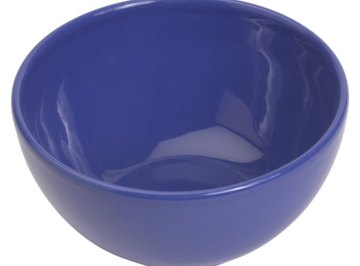
Cobalt (Co) is the the 27th element in the periodic table of elements and is a member of the transition metal family. According to Georgia State University, cobalt is commonly found in complex with arsenic, sulfur, copper and even chlorine. Pomona College points out that cobalt has long been known to humans and was utilized in ancient Persia as a pigment in pottery. Cobalt can be a dangerous substance, and the University of Maryland medical center indicates that ingestion, inhalation or long-term skin contact can lead to cobalt poisoning. In addition, cobalt 60 is a highly radioactive byproduct of some nuclear weapons.
Cobalt and Arsenic
Like most metals, cobalt is not commonly found in isolation as a pure element. Generally, it is found mixed with other elements -- one of which is arsenic. Cobalt and arsenic combine into CoAs(2) or CoAs(3), which are known as safflorite and skutterudite respectively, according to Georgia State University. Cobalt and arsenic together tend to form larger complexes with additional metals and nonmetals as well, an example being CoAsS or cobalt arsenic sulfide.
Cobalt and Sulfur
Cobalt is often found in conjunction with sulfur, either as part of a larger complex like CoAsS or as part of a sulfide, such as Co(3)S(4). This mineral is gray to black in color and shines in a manner similar to obsidian. Cobalt-sulfur compounds also exist that are effectively highly complex mergers of multiple metals, such as cobalt, nickel and copper with sulfur atoms. Sulfur's special ability to form more than four bonds with other elements allows it to exist in complex with a number of metals.
Cobalt and Other Metals
Cobalt is commonly found in ores and minerals in conjunction with a variety of other transition metals. In carrollite -- Cu[(NiCo)(2)]S(4) -- cobalt is tightly bonded to nickel and in complex with a central copper atom as well as four sulfur counter-ions. Cobalt can also merge with arsenic and sulfur to bond with iron in a molecule with the formula (CoFe)AsS. Cobalt's ability to bond with so many other valuable elements has caused miners much grief, according to Pomona College, as it can be mistaken for silver and when melted down forms poisonous gases.
Cobalt and Nonmetals
Cobalt also bonds with chlorine to form cobalt chloride and oxygen to form cobalt oxide. Cobalt oxide is particularly valuable and common as it is the cobalt complex that is used to provide a blue pigment to glassware that is otherwise difficult to synthesize. This complex of cobalt and oxygen also makes its way into blue paints. When used in this manner cobalt is quite inert, and does not pose a known health hazard in contrast to elemental cobalt.
References
About the Author
Damien Thryn holds a bachelor's degree in political science from the University of California at Berkeley. Specializing in writing on video games, he has played PC games for more than 20 years and has written about many classics. He is also an avid console gamer.
Photo Credits
Hemera Technologies/PhotoObjects.net/Getty Images
